Effective Teacher-Student Engagement: A Classroom Learning Analysis
VerifiedAdded on 2023/06/07
|8
|2000
|372
Essay
AI Summary
This essay explores the critical role of teacher-student relationships in fostering a positive and effective classroom learning environment. It emphasizes that strong engagement and positive relationships between teachers and students are essential for students to understand content and succeed academically. The essay draws upon various theories, including those of Piaget and Vygotsky, to highlight the impact of social interactions and environmental factors on cognitive development. It addresses challenges such as students with single parents needing extra support, difficulties in settling into class, and a lack of focus during lessons. The essay suggests strategies for teachers to build virtuous relationships, including understanding student personalities, providing personalized assistance, using positive reinforcement, and creating a fun and engaging learning environment through stories and humor. Ultimately, the essay underscores the importance of teachers demonstrating care and support to motivate students and create a supportive atmosphere conducive to social and academic growth. Desklib provides a platform to explore more such insightful essays and solved assignments.
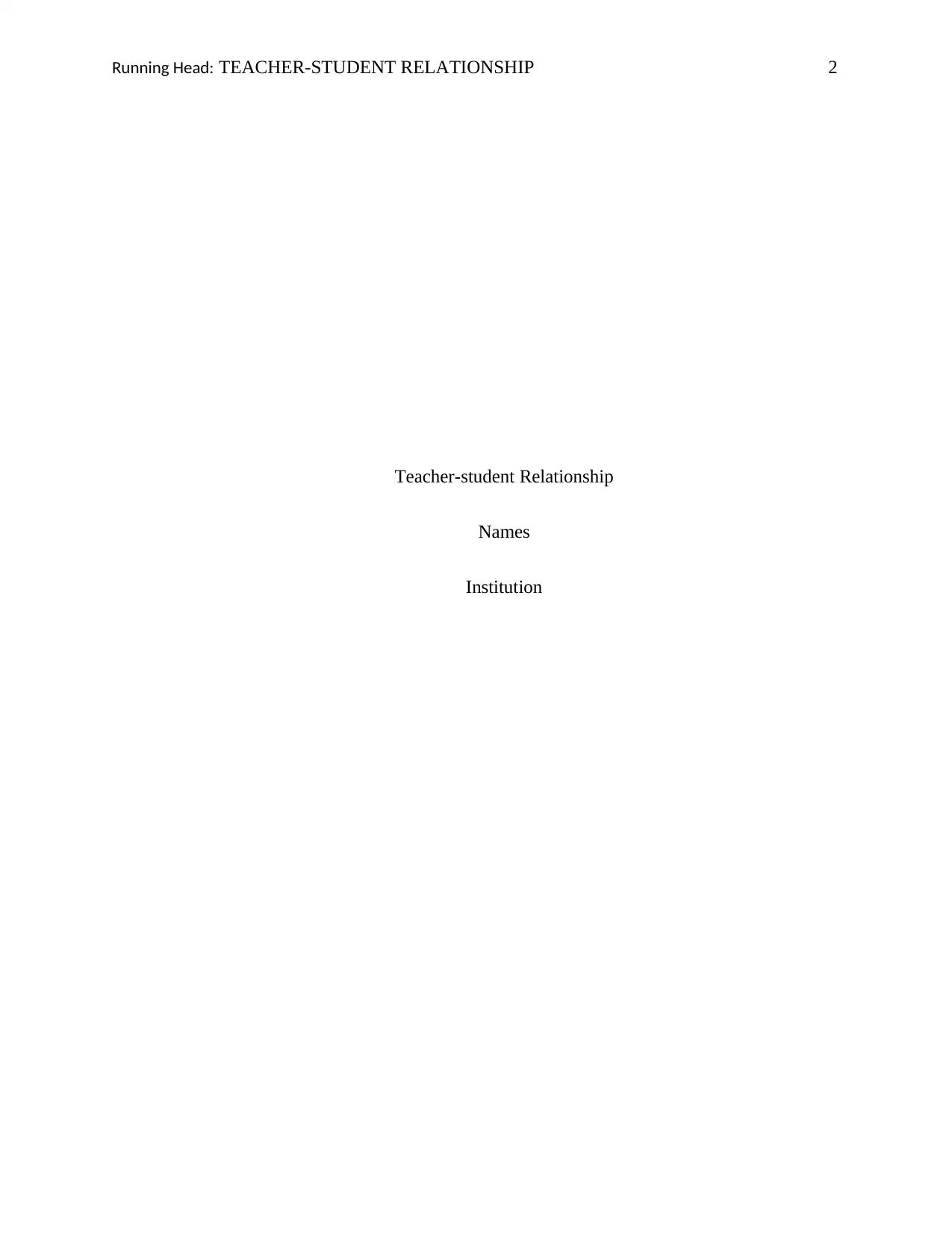
Running Head: TEACHER-STUDENT RELATIONSHIP 2
Teacher-student Relationship
Names
Institution
Teacher-student Relationship
Names
Institution
Secure Best Marks with AI Grader
Need help grading? Try our AI Grader for instant feedback on your assignments.
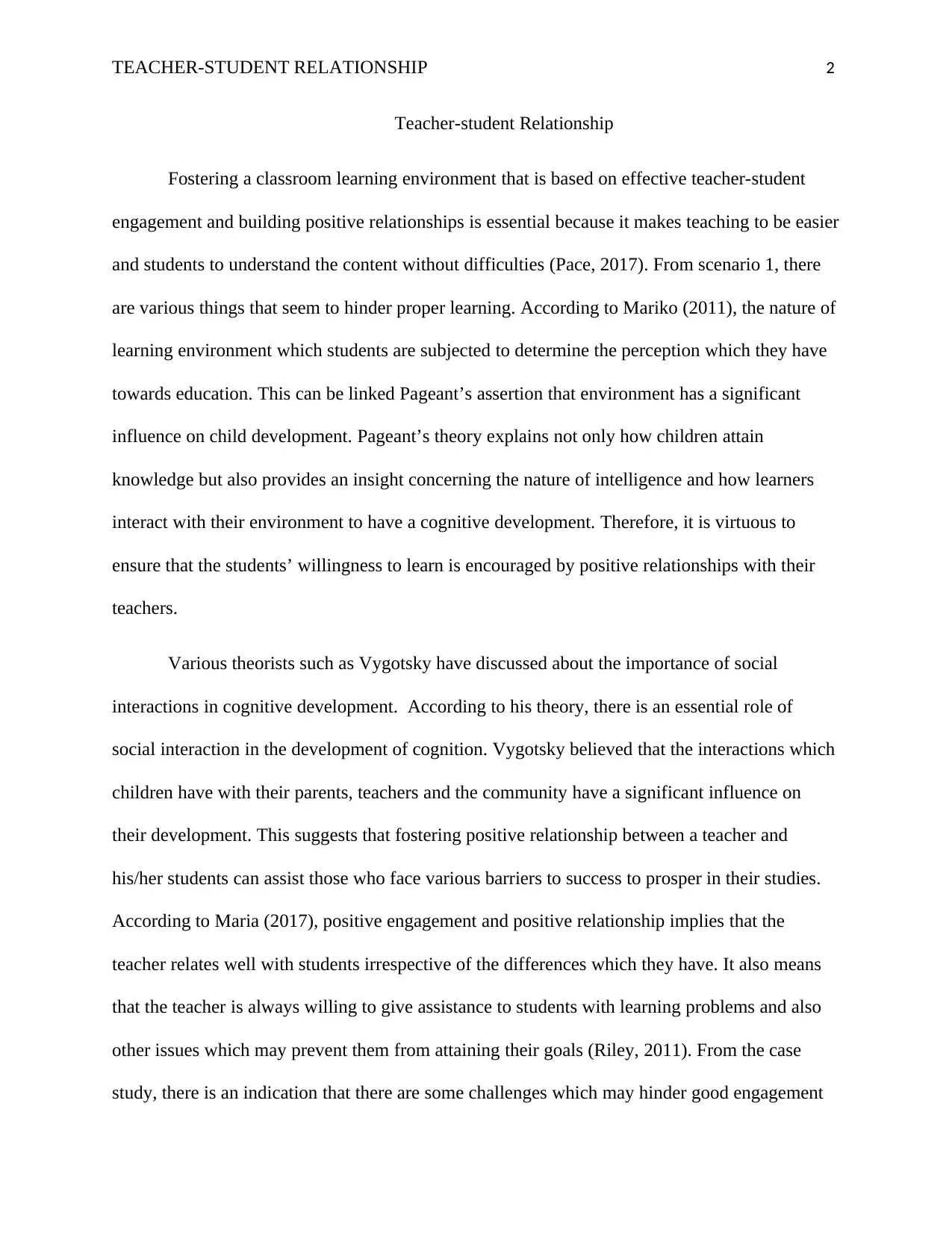
TEACHER-STUDENT RELATIONSHIP 2
Teacher-student Relationship
Fostering a classroom learning environment that is based on effective teacher-student
engagement and building positive relationships is essential because it makes teaching to be easier
and students to understand the content without difficulties (Pace, 2017). From scenario 1, there
are various things that seem to hinder proper learning. According to Mariko (2011), the nature of
learning environment which students are subjected to determine the perception which they have
towards education. This can be linked Pageant’s assertion that environment has a significant
influence on child development. Pageant’s theory explains not only how children attain
knowledge but also provides an insight concerning the nature of intelligence and how learners
interact with their environment to have a cognitive development. Therefore, it is virtuous to
ensure that the students’ willingness to learn is encouraged by positive relationships with their
teachers.
Various theorists such as Vygotsky have discussed about the importance of social
interactions in cognitive development. According to his theory, there is an essential role of
social interaction in the development of cognition. Vygotsky believed that the interactions which
children have with their parents, teachers and the community have a significant influence on
their development. This suggests that fostering positive relationship between a teacher and
his/her students can assist those who face various barriers to success to prosper in their studies.
According to Maria (2017), positive engagement and positive relationship implies that the
teacher relates well with students irrespective of the differences which they have. It also means
that the teacher is always willing to give assistance to students with learning problems and also
other issues which may prevent them from attaining their goals (Riley, 2011). From the case
study, there is an indication that there are some challenges which may hinder good engagement
Teacher-student Relationship
Fostering a classroom learning environment that is based on effective teacher-student
engagement and building positive relationships is essential because it makes teaching to be easier
and students to understand the content without difficulties (Pace, 2017). From scenario 1, there
are various things that seem to hinder proper learning. According to Mariko (2011), the nature of
learning environment which students are subjected to determine the perception which they have
towards education. This can be linked Pageant’s assertion that environment has a significant
influence on child development. Pageant’s theory explains not only how children attain
knowledge but also provides an insight concerning the nature of intelligence and how learners
interact with their environment to have a cognitive development. Therefore, it is virtuous to
ensure that the students’ willingness to learn is encouraged by positive relationships with their
teachers.
Various theorists such as Vygotsky have discussed about the importance of social
interactions in cognitive development. According to his theory, there is an essential role of
social interaction in the development of cognition. Vygotsky believed that the interactions which
children have with their parents, teachers and the community have a significant influence on
their development. This suggests that fostering positive relationship between a teacher and
his/her students can assist those who face various barriers to success to prosper in their studies.
According to Maria (2017), positive engagement and positive relationship implies that the
teacher relates well with students irrespective of the differences which they have. It also means
that the teacher is always willing to give assistance to students with learning problems and also
other issues which may prevent them from attaining their goals (Riley, 2011). From the case
study, there is an indication that there are some challenges which may hinder good engagement
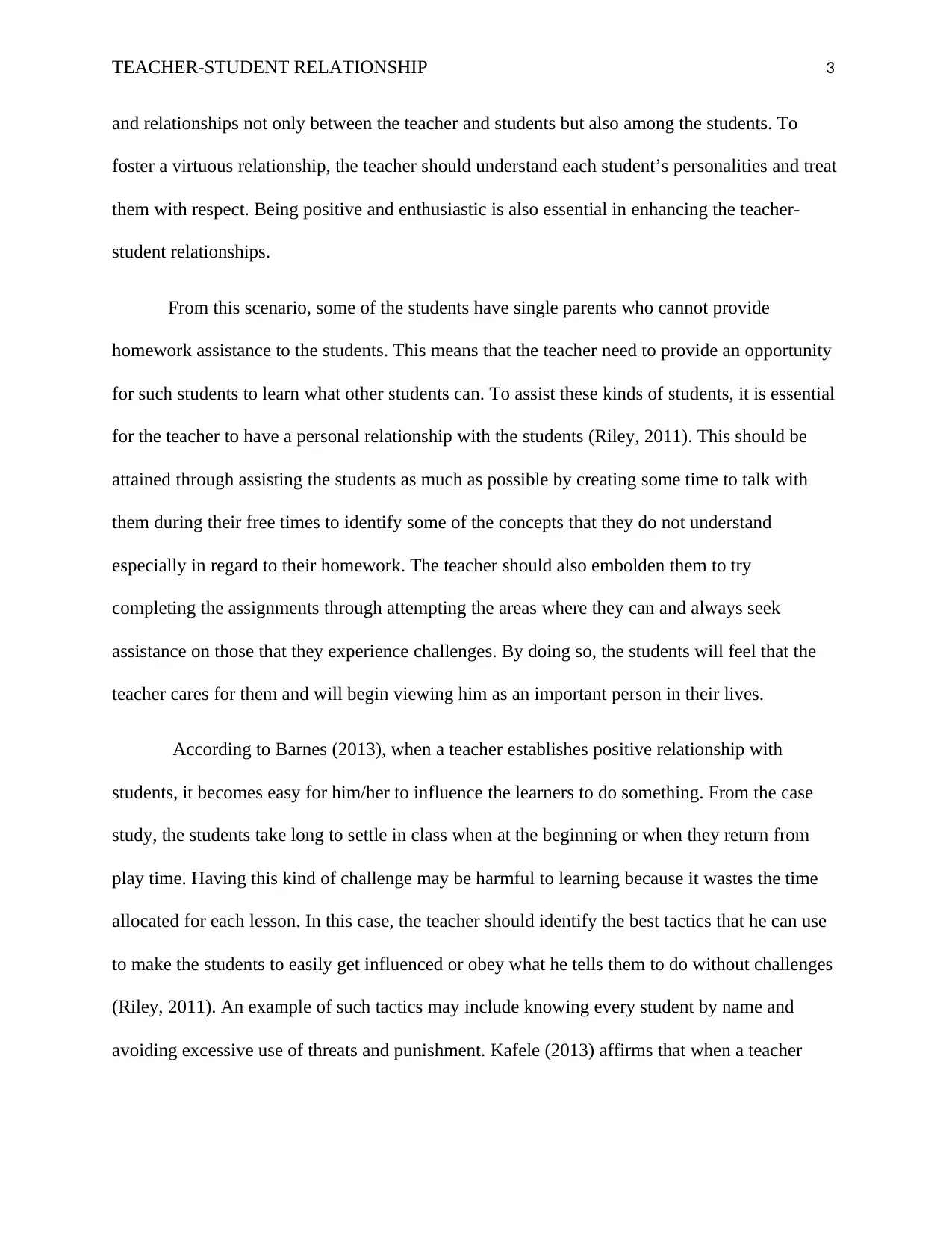
TEACHER-STUDENT RELATIONSHIP 3
and relationships not only between the teacher and students but also among the students. To
foster a virtuous relationship, the teacher should understand each student’s personalities and treat
them with respect. Being positive and enthusiastic is also essential in enhancing the teacher-
student relationships.
From this scenario, some of the students have single parents who cannot provide
homework assistance to the students. This means that the teacher need to provide an opportunity
for such students to learn what other students can. To assist these kinds of students, it is essential
for the teacher to have a personal relationship with the students (Riley, 2011). This should be
attained through assisting the students as much as possible by creating some time to talk with
them during their free times to identify some of the concepts that they do not understand
especially in regard to their homework. The teacher should also embolden them to try
completing the assignments through attempting the areas where they can and always seek
assistance on those that they experience challenges. By doing so, the students will feel that the
teacher cares for them and will begin viewing him as an important person in their lives.
According to Barnes (2013), when a teacher establishes positive relationship with
students, it becomes easy for him/her to influence the learners to do something. From the case
study, the students take long to settle in class when at the beginning or when they return from
play time. Having this kind of challenge may be harmful to learning because it wastes the time
allocated for each lesson. In this case, the teacher should identify the best tactics that he can use
to make the students to easily get influenced or obey what he tells them to do without challenges
(Riley, 2011). An example of such tactics may include knowing every student by name and
avoiding excessive use of threats and punishment. Kafele (2013) affirms that when a teacher
and relationships not only between the teacher and students but also among the students. To
foster a virtuous relationship, the teacher should understand each student’s personalities and treat
them with respect. Being positive and enthusiastic is also essential in enhancing the teacher-
student relationships.
From this scenario, some of the students have single parents who cannot provide
homework assistance to the students. This means that the teacher need to provide an opportunity
for such students to learn what other students can. To assist these kinds of students, it is essential
for the teacher to have a personal relationship with the students (Riley, 2011). This should be
attained through assisting the students as much as possible by creating some time to talk with
them during their free times to identify some of the concepts that they do not understand
especially in regard to their homework. The teacher should also embolden them to try
completing the assignments through attempting the areas where they can and always seek
assistance on those that they experience challenges. By doing so, the students will feel that the
teacher cares for them and will begin viewing him as an important person in their lives.
According to Barnes (2013), when a teacher establishes positive relationship with
students, it becomes easy for him/her to influence the learners to do something. From the case
study, the students take long to settle in class when at the beginning or when they return from
play time. Having this kind of challenge may be harmful to learning because it wastes the time
allocated for each lesson. In this case, the teacher should identify the best tactics that he can use
to make the students to easily get influenced or obey what he tells them to do without challenges
(Riley, 2011). An example of such tactics may include knowing every student by name and
avoiding excessive use of threats and punishment. Kafele (2013) affirms that when a teacher
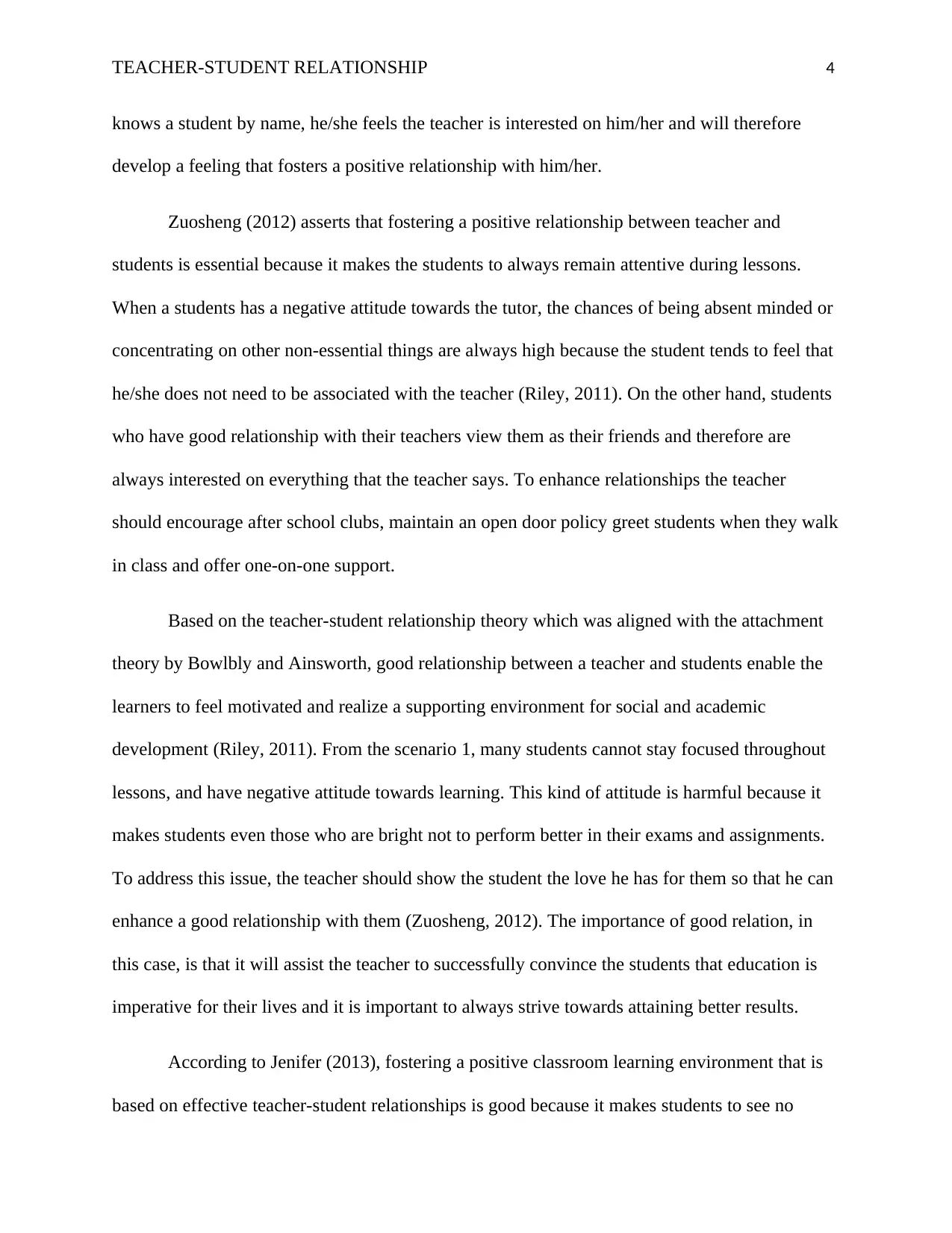
TEACHER-STUDENT RELATIONSHIP 4
knows a student by name, he/she feels the teacher is interested on him/her and will therefore
develop a feeling that fosters a positive relationship with him/her.
Zuosheng (2012) asserts that fostering a positive relationship between teacher and
students is essential because it makes the students to always remain attentive during lessons.
When a students has a negative attitude towards the tutor, the chances of being absent minded or
concentrating on other non-essential things are always high because the student tends to feel that
he/she does not need to be associated with the teacher (Riley, 2011). On the other hand, students
who have good relationship with their teachers view them as their friends and therefore are
always interested on everything that the teacher says. To enhance relationships the teacher
should encourage after school clubs, maintain an open door policy greet students when they walk
in class and offer one-on-one support.
Based on the teacher-student relationship theory which was aligned with the attachment
theory by Bowlbly and Ainsworth, good relationship between a teacher and students enable the
learners to feel motivated and realize a supporting environment for social and academic
development (Riley, 2011). From the scenario 1, many students cannot stay focused throughout
lessons, and have negative attitude towards learning. This kind of attitude is harmful because it
makes students even those who are bright not to perform better in their exams and assignments.
To address this issue, the teacher should show the student the love he has for them so that he can
enhance a good relationship with them (Zuosheng, 2012). The importance of good relation, in
this case, is that it will assist the teacher to successfully convince the students that education is
imperative for their lives and it is important to always strive towards attaining better results.
According to Jenifer (2013), fostering a positive classroom learning environment that is
based on effective teacher-student relationships is good because it makes students to see no
knows a student by name, he/she feels the teacher is interested on him/her and will therefore
develop a feeling that fosters a positive relationship with him/her.
Zuosheng (2012) asserts that fostering a positive relationship between teacher and
students is essential because it makes the students to always remain attentive during lessons.
When a students has a negative attitude towards the tutor, the chances of being absent minded or
concentrating on other non-essential things are always high because the student tends to feel that
he/she does not need to be associated with the teacher (Riley, 2011). On the other hand, students
who have good relationship with their teachers view them as their friends and therefore are
always interested on everything that the teacher says. To enhance relationships the teacher
should encourage after school clubs, maintain an open door policy greet students when they walk
in class and offer one-on-one support.
Based on the teacher-student relationship theory which was aligned with the attachment
theory by Bowlbly and Ainsworth, good relationship between a teacher and students enable the
learners to feel motivated and realize a supporting environment for social and academic
development (Riley, 2011). From the scenario 1, many students cannot stay focused throughout
lessons, and have negative attitude towards learning. This kind of attitude is harmful because it
makes students even those who are bright not to perform better in their exams and assignments.
To address this issue, the teacher should show the student the love he has for them so that he can
enhance a good relationship with them (Zuosheng, 2012). The importance of good relation, in
this case, is that it will assist the teacher to successfully convince the students that education is
imperative for their lives and it is important to always strive towards attaining better results.
According to Jenifer (2013), fostering a positive classroom learning environment that is
based on effective teacher-student relationships is good because it makes students to see no
Secure Best Marks with AI Grader
Need help grading? Try our AI Grader for instant feedback on your assignments.
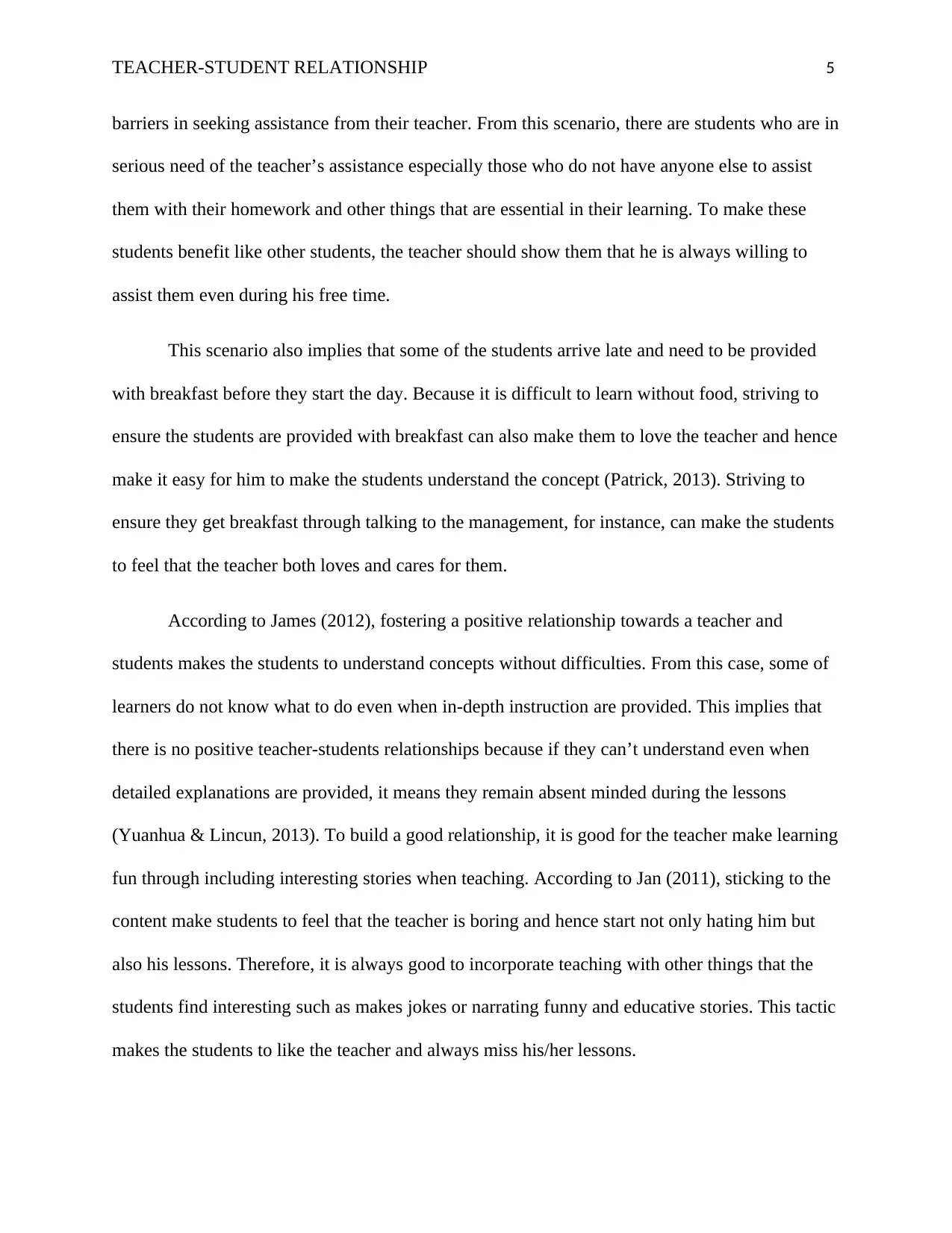
TEACHER-STUDENT RELATIONSHIP 5
barriers in seeking assistance from their teacher. From this scenario, there are students who are in
serious need of the teacher’s assistance especially those who do not have anyone else to assist
them with their homework and other things that are essential in their learning. To make these
students benefit like other students, the teacher should show them that he is always willing to
assist them even during his free time.
This scenario also implies that some of the students arrive late and need to be provided
with breakfast before they start the day. Because it is difficult to learn without food, striving to
ensure the students are provided with breakfast can also make them to love the teacher and hence
make it easy for him to make the students understand the concept (Patrick, 2013). Striving to
ensure they get breakfast through talking to the management, for instance, can make the students
to feel that the teacher both loves and cares for them.
According to James (2012), fostering a positive relationship towards a teacher and
students makes the students to understand concepts without difficulties. From this case, some of
learners do not know what to do even when in-depth instruction are provided. This implies that
there is no positive teacher-students relationships because if they can’t understand even when
detailed explanations are provided, it means they remain absent minded during the lessons
(Yuanhua & Lincun, 2013). To build a good relationship, it is good for the teacher make learning
fun through including interesting stories when teaching. According to Jan (2011), sticking to the
content make students to feel that the teacher is boring and hence start not only hating him but
also his lessons. Therefore, it is always good to incorporate teaching with other things that the
students find interesting such as makes jokes or narrating funny and educative stories. This tactic
makes the students to like the teacher and always miss his/her lessons.
barriers in seeking assistance from their teacher. From this scenario, there are students who are in
serious need of the teacher’s assistance especially those who do not have anyone else to assist
them with their homework and other things that are essential in their learning. To make these
students benefit like other students, the teacher should show them that he is always willing to
assist them even during his free time.
This scenario also implies that some of the students arrive late and need to be provided
with breakfast before they start the day. Because it is difficult to learn without food, striving to
ensure the students are provided with breakfast can also make them to love the teacher and hence
make it easy for him to make the students understand the concept (Patrick, 2013). Striving to
ensure they get breakfast through talking to the management, for instance, can make the students
to feel that the teacher both loves and cares for them.
According to James (2012), fostering a positive relationship towards a teacher and
students makes the students to understand concepts without difficulties. From this case, some of
learners do not know what to do even when in-depth instruction are provided. This implies that
there is no positive teacher-students relationships because if they can’t understand even when
detailed explanations are provided, it means they remain absent minded during the lessons
(Yuanhua & Lincun, 2013). To build a good relationship, it is good for the teacher make learning
fun through including interesting stories when teaching. According to Jan (2011), sticking to the
content make students to feel that the teacher is boring and hence start not only hating him but
also his lessons. Therefore, it is always good to incorporate teaching with other things that the
students find interesting such as makes jokes or narrating funny and educative stories. This tactic
makes the students to like the teacher and always miss his/her lessons.
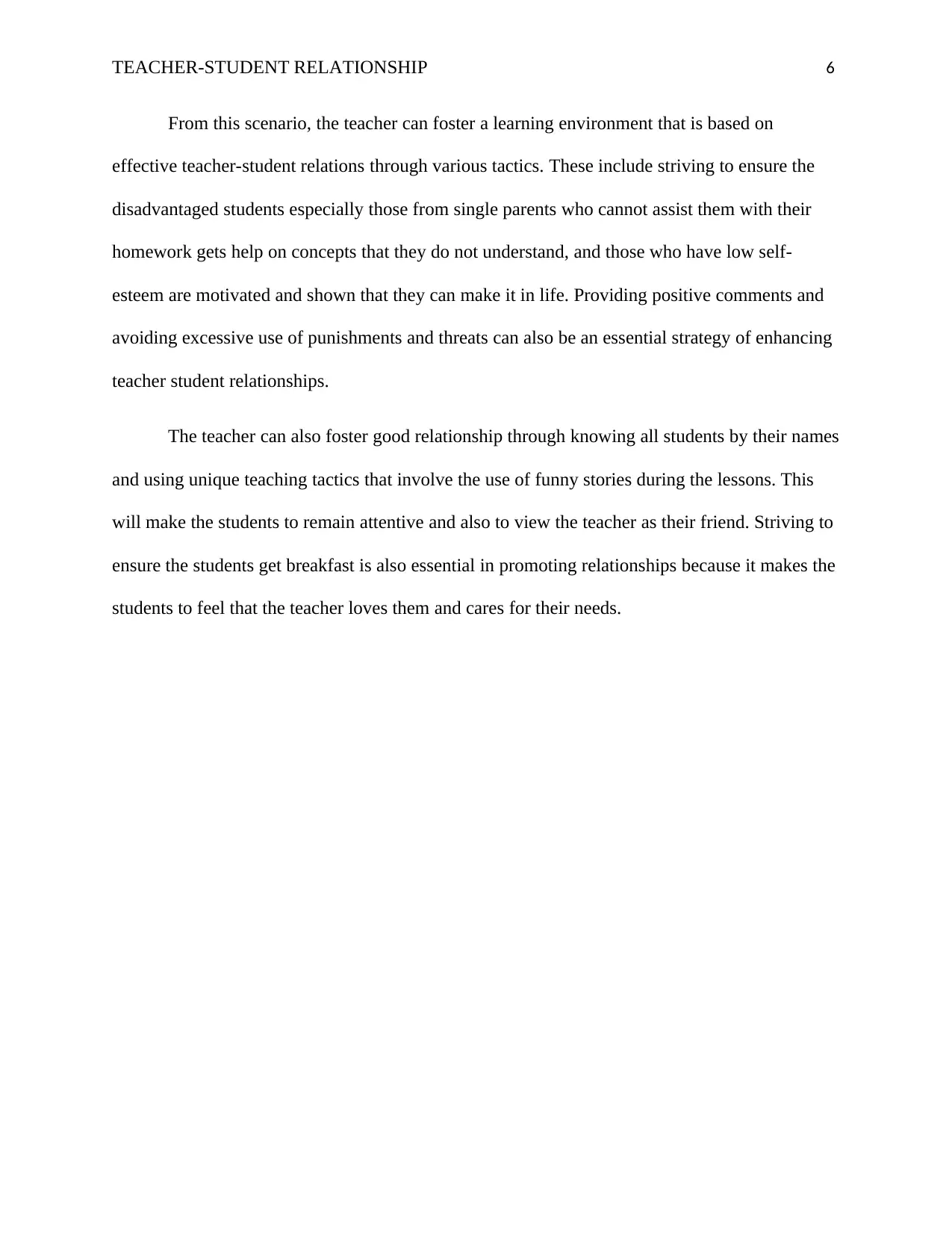
TEACHER-STUDENT RELATIONSHIP 6
From this scenario, the teacher can foster a learning environment that is based on
effective teacher-student relations through various tactics. These include striving to ensure the
disadvantaged students especially those from single parents who cannot assist them with their
homework gets help on concepts that they do not understand, and those who have low self-
esteem are motivated and shown that they can make it in life. Providing positive comments and
avoiding excessive use of punishments and threats can also be an essential strategy of enhancing
teacher student relationships.
The teacher can also foster good relationship through knowing all students by their names
and using unique teaching tactics that involve the use of funny stories during the lessons. This
will make the students to remain attentive and also to view the teacher as their friend. Striving to
ensure the students get breakfast is also essential in promoting relationships because it makes the
students to feel that the teacher loves them and cares for their needs.
From this scenario, the teacher can foster a learning environment that is based on
effective teacher-student relations through various tactics. These include striving to ensure the
disadvantaged students especially those from single parents who cannot assist them with their
homework gets help on concepts that they do not understand, and those who have low self-
esteem are motivated and shown that they can make it in life. Providing positive comments and
avoiding excessive use of punishments and threats can also be an essential strategy of enhancing
teacher student relationships.
The teacher can also foster good relationship through knowing all students by their names
and using unique teaching tactics that involve the use of funny stories during the lessons. This
will make the students to remain attentive and also to view the teacher as their friend. Striving to
ensure the students get breakfast is also essential in promoting relationships because it makes the
students to feel that the teacher loves them and cares for their needs.
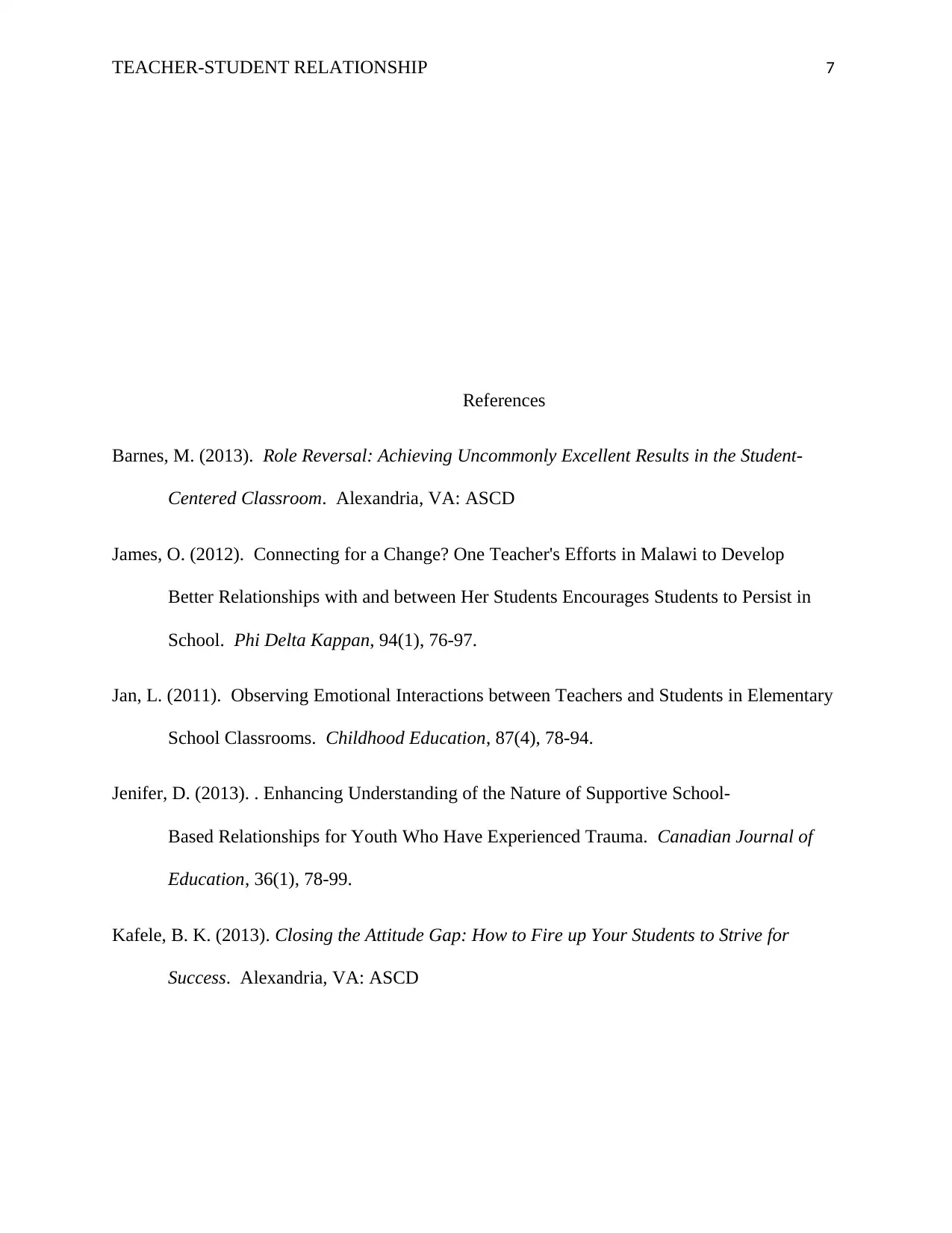
TEACHER-STUDENT RELATIONSHIP 7
References
Barnes, M. (2013). Role Reversal: Achieving Uncommonly Excellent Results in the Student-
Centered Classroom. Alexandria, VA: ASCD
James, O. (2012). Connecting for a Change? One Teacher's Efforts in Malawi to Develop
Better Relationships with and between Her Students Encourages Students to Persist in
School. Phi Delta Kappan, 94(1), 76-97.
Jan, L. (2011). Observing Emotional Interactions between Teachers and Students in Elementary
School Classrooms. Childhood Education, 87(4), 78-94.
Jenifer, D. (2013). . Enhancing Understanding of the Nature of Supportive School-
Based Relationships for Youth Who Have Experienced Trauma. Canadian Journal of
Education, 36(1), 78-99.
Kafele, B. K. (2013). Closing the Attitude Gap: How to Fire up Your Students to Strive for
Success. Alexandria, VA: ASCD
References
Barnes, M. (2013). Role Reversal: Achieving Uncommonly Excellent Results in the Student-
Centered Classroom. Alexandria, VA: ASCD
James, O. (2012). Connecting for a Change? One Teacher's Efforts in Malawi to Develop
Better Relationships with and between Her Students Encourages Students to Persist in
School. Phi Delta Kappan, 94(1), 76-97.
Jan, L. (2011). Observing Emotional Interactions between Teachers and Students in Elementary
School Classrooms. Childhood Education, 87(4), 78-94.
Jenifer, D. (2013). . Enhancing Understanding of the Nature of Supportive School-
Based Relationships for Youth Who Have Experienced Trauma. Canadian Journal of
Education, 36(1), 78-99.
Kafele, B. K. (2013). Closing the Attitude Gap: How to Fire up Your Students to Strive for
Success. Alexandria, VA: ASCD
Paraphrase This Document
Need a fresh take? Get an instant paraphrase of this document with our AI Paraphraser
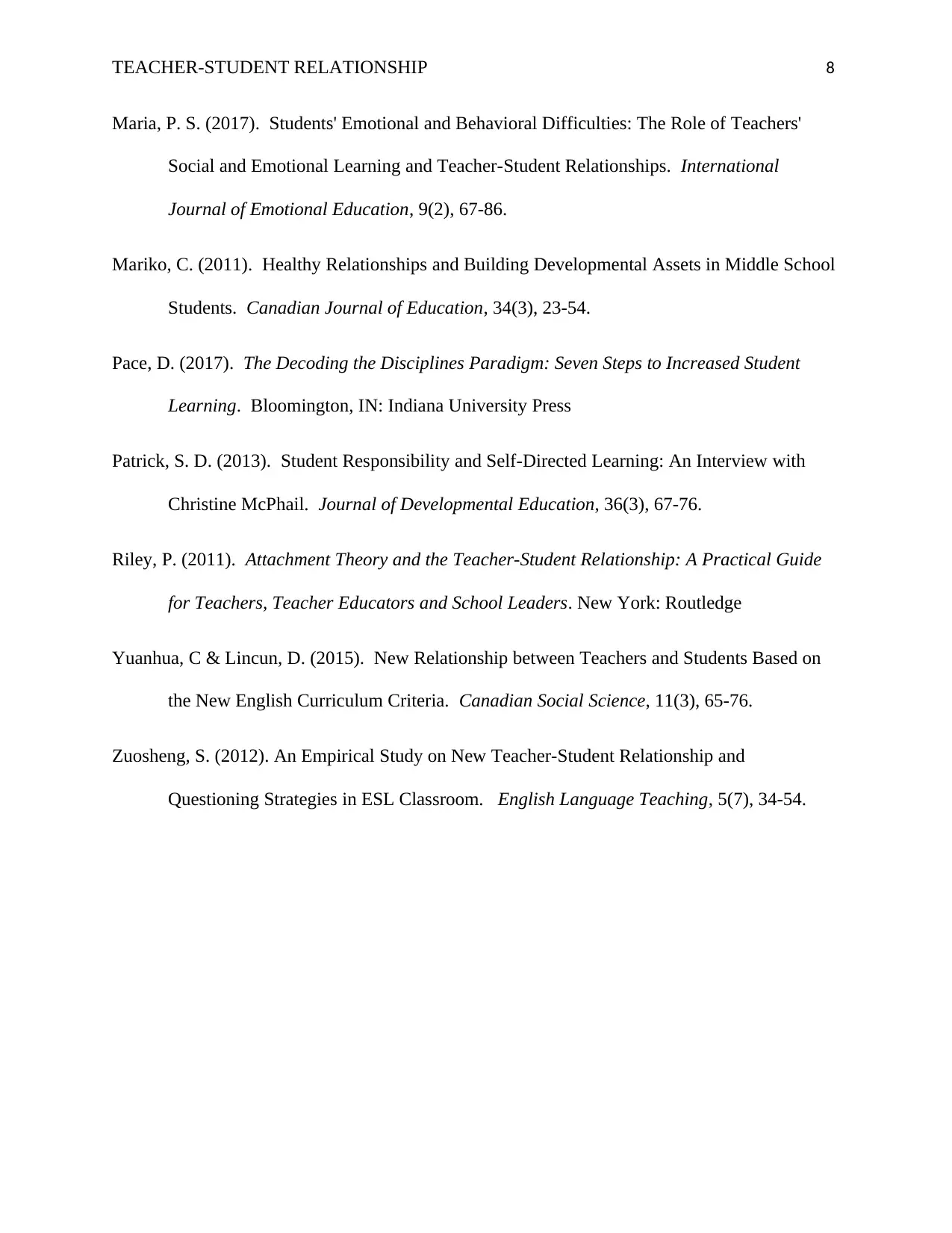
TEACHER-STUDENT RELATIONSHIP 8
Maria, P. S. (2017). Students' Emotional and Behavioral Difficulties: The Role of Teachers'
Social and Emotional Learning and Teacher-Student Relationships. International
Journal of Emotional Education, 9(2), 67-86.
Mariko, C. (2011). Healthy Relationships and Building Developmental Assets in Middle School
Students. Canadian Journal of Education, 34(3), 23-54.
Pace, D. (2017). The Decoding the Disciplines Paradigm: Seven Steps to Increased Student
Learning. Bloomington, IN: Indiana University Press
Patrick, S. D. (2013). Student Responsibility and Self-Directed Learning: An Interview with
Christine McPhail. Journal of Developmental Education, 36(3), 67-76.
Riley, P. (2011). Attachment Theory and the Teacher-Student Relationship: A Practical Guide
for Teachers, Teacher Educators and School Leaders. New York: Routledge
Yuanhua, C & Lincun, D. (2015). New Relationship between Teachers and Students Based on
the New English Curriculum Criteria. Canadian Social Science, 11(3), 65-76.
Zuosheng, S. (2012). An Empirical Study on New Teacher-Student Relationship and
Questioning Strategies in ESL Classroom. English Language Teaching, 5(7), 34-54.
Maria, P. S. (2017). Students' Emotional and Behavioral Difficulties: The Role of Teachers'
Social and Emotional Learning and Teacher-Student Relationships. International
Journal of Emotional Education, 9(2), 67-86.
Mariko, C. (2011). Healthy Relationships and Building Developmental Assets in Middle School
Students. Canadian Journal of Education, 34(3), 23-54.
Pace, D. (2017). The Decoding the Disciplines Paradigm: Seven Steps to Increased Student
Learning. Bloomington, IN: Indiana University Press
Patrick, S. D. (2013). Student Responsibility and Self-Directed Learning: An Interview with
Christine McPhail. Journal of Developmental Education, 36(3), 67-76.
Riley, P. (2011). Attachment Theory and the Teacher-Student Relationship: A Practical Guide
for Teachers, Teacher Educators and School Leaders. New York: Routledge
Yuanhua, C & Lincun, D. (2015). New Relationship between Teachers and Students Based on
the New English Curriculum Criteria. Canadian Social Science, 11(3), 65-76.
Zuosheng, S. (2012). An Empirical Study on New Teacher-Student Relationship and
Questioning Strategies in ESL Classroom. English Language Teaching, 5(7), 34-54.
1 out of 8
Related Documents
Your All-in-One AI-Powered Toolkit for Academic Success.
+13062052269
info@desklib.com
Available 24*7 on WhatsApp / Email
![[object Object]](/_next/static/media/star-bottom.7253800d.svg)
Unlock your academic potential
© 2024 | Zucol Services PVT LTD | All rights reserved.




